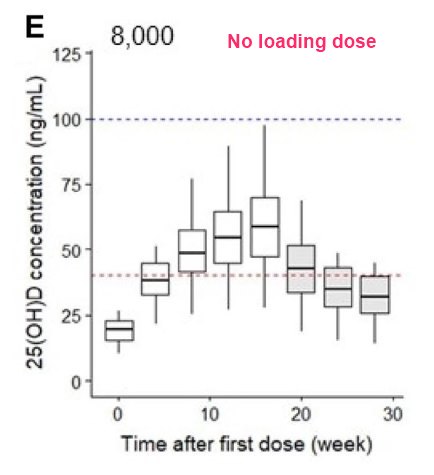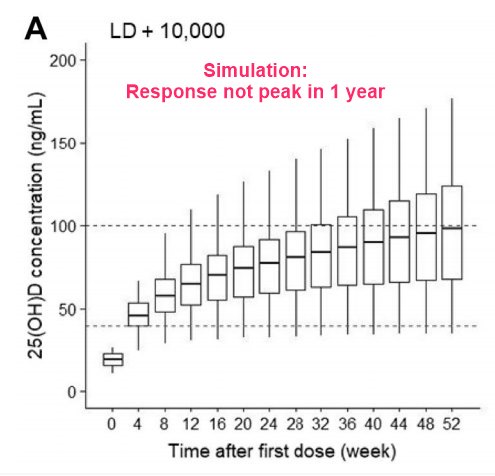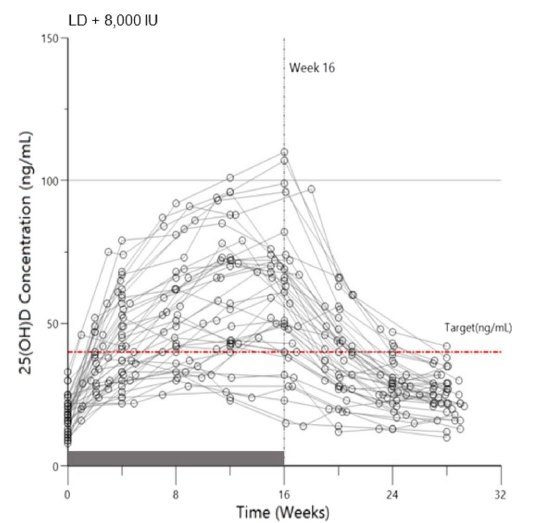Children who are overweight or asthmatic need more Vitamin D
Pharmacokinetics of Oral Vitamin D in Children with Obesity and Asthma
Clin Pharmacokinet. 2023 Aug 30. doi: 10.1007/s40262-023-01285-9
Jason E Lang 1 2, Rodrigo Gonzalez Ramirez 3, Stephen Balevic 4 3, Scott Bickel 5, Christoph P Hornik 4 3, J Marc Majure 6, Saranya Venkatachalam 3, Jessica Snowden 7, Brian O'Sullivan 8, Laura James 7
Both overweight and asthma are known to reduce Vitamin D response




Note: Some of the children (age 6-15) did not get >43 ng in 4 months
Background and objective: Vitamin D insufficiency is common in several pediatric diseases including obesity and asthma. Little data exist describing the pharmacokinetics of oral vitamin D in children or the optimal dosing to achieve therapeutic 25(OH)D targets. Describe the pharmacokinetics of oral Vitamin D in children with asthma.
Methods: This was a multi-center, randomized, open-label, oral supplementation study to describe the pharmacokinetics of vitamin D in children aged 6-17 years who have asthma and were overweight/obese. Participants had a serum 25(OH)D concentration between 10 and < 30 ng/mL at baseline. In Part 1 of the study, we assessed four 16-week dosing regimens for their ability to achieve 25(OH)D concentrations ≥ 40 ng/mL. Using serial serum 25(OH)D sampling over 28 weeks, we created a population pharmacokinetic model and performed dosing simulations to achieve 25(OH)D concentrations ≥ 40 ng/mL. In Part 2, the optimal regimen chosen from Part 1 was compared (2:1) to a standard-of-care control dose (600 international units [IU] daily) over 16 weeks. A final population pharmacokinetic model using both parts was developed to perform dosing simulations and determine important co-variates in the pharmacokinetics of vitamin D.
Results: Based on empiric and simulation data, the daily dose of 8000 IU and a loading dose of 50,000 IU were chosen; this regimen raised 25(OH)D concentrations above 40 ng/mL in the majority of participants while avoiding concentrations > 100 ng/mL. A 50,000-IU loading dose led to faster achievement of 25(OH)D therapeutic concentrations (≥ 40 ng/mL). The estimated median (5th-95th percentiles) apparent clearance of vitamin D from the final population pharmacokinetic model was 0.181 (0.155-0.206) L/h. The body mass index z-score was a significant covariate on apparent clearance and was associated with a significantly decreased median half-life in 25(OH)D (body mass index z-score 1.00-1.99: 97.7 days, body mass index z-score 2.00-2.99: 65.9 days, body mass index z-score ≥ 3.00: 39.1 days, p < 0.001).
Conclusions: Obesity impacts vitamin D clearance and the half-life, but serum concentrations > 40 ng/mL can be reached in most children using a loading dose of 50,000 IU followed by a daily dose of 8000 IU.
📄 Download the PDF from Vitamin D Life
158+ Vitamin D Life pages contain ASTHMA... in the title
which includes:
Resulting childhood Asthma cut in half if 4,400 IU Vitamin D daily while pregnant - RCT April 2023
Asthma probably fought by Vitamin D in more than 4 ways – review May 2023
Asthma treated by Vitamin D - 13th Meta-analysis – July 2022
Wheezing and asthmatic children have weaker Vitamin D responses - May 2022
Vitamin D Life – Overview Obesity and Vitamin D contains:
{include}
{include}
Vitamin D Life - studies in both categories Obesity and Infant-Child
This list is automatically updated
{category}
